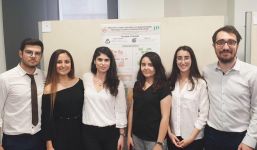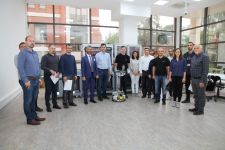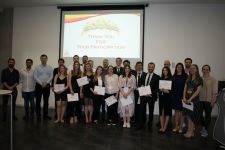
FACULTY OF ENGINEERING
Department of Industrial Engineering
IE 333 | Course Introduction and Application Information
| Course Name |
Manufacturing Automation
|
|
Code
|
Semester
|
Theory
(hour/week) |
Application/Lab
(hour/week) |
Local Credits
|
ECTS
|
|
IE 333
|
Fall/Spring
|
3
|
0
|
3
|
5
|
| Prerequisites |
None
|
|||||
| Course Language |
English
|
|||||
| Course Type |
Service Course
|
|||||
| Course Level |
First Cycle
|
|||||
| Mode of Delivery | - | |||||
| Teaching Methods and Techniques of the Course | - | |||||
| Course Coordinator | - | |||||
| Course Lecturer(s) | - | |||||
| Assistant(s) | - | |||||
| Course Objectives | - Understand and explain basic concepts related to automation of design and manufacturing - Give a broad view of hardware elements used in automation. |
| Learning Outcomes |
The students who succeeded in this course;
|
| Course Description | Production systems and automation, Manufacturing systems – Classification of industries and basic concepts, Basic chip removal processes, Automation and its basic hardware, Numerical Control technology and types of NC concept, Principles of NC programming, Robot anatomy and applications, PLC’s. |
|
|
Core Courses | |
| Major Area Courses |
X
|
|
| Supportive Courses | ||
| Media and Management Skills Courses | ||
| Transferable Skill Courses |
WEEKLY SUBJECTS AND RELATED PREPARATION STUDIES
| Week | Subjects | Related Preparation |
| 1 | Production Systems and Automation: Introduction; Automation in production systems; Manual labor in production systems; Automation principles and strategies | Chapter 1; "Automation, Production Systems, and Computer-Integrated Manufacturing", Mikell P. Groover, Second Edition, Prentice Hall Inc. |
| 2 | Manufacturing Systems: Classification of industries; Manufacturing operations; Production facilities | Chapter 2; "Automation, Production Systems, and Computer-Integrated Manufacturing", Mikell P. Groover, Second Edition, Prentice Hall Inc. |
| 3 | Material (Chip) Removal Processes: Chip removal theory; Turning; Hole processing operations; Milling | Lecture notes |
| 4 | Material Removal (Chip) Processes: Surface operations; Non-traditional machining processes | Lecture notes |
| 5 | Introduction to Automation: Basic elements of automated systems; Advanced automation functions; Levels of Automation | Chapter 3; "Automation, Production Systems, and Computer-Integrated Manufacturing", Mikell P. Groover, Second Edition, Prentice Hall Inc |
| 6 | Hardware Components: Sensors and actuators; Analog-to-Digital conversion; | Chapter 5; "Automation, Production Systems, and Computer-Integrated Manufacturing", Mikell P. Groover, Second Edition, Prentice Hall Inc. |
| 7 | Hardware Components: Digital-to-Analog conversion; I/O devices for discrete data | Chapter 5; "Automation, Production Systems, and Computer-Integrated Manufacturing", Mikell P. Groover, Second Edition, Prentice Hall Inc. |
| 8 | Review and Midterm | |
| 9 | Numerical Control: Fundamentals of NC technology; CNC and DNC; | Chapter 6; "Automation, Production Systems, and Computer-Integrated Manufacturing", Mikell P. Groover, Second Edition, Prentice Hall Inc. |
| 10 | Numerical Control : Applications of numerical control and basic control principles | Chapter 6; "Automation, Production Systems, and Computer-Integrated Manufacturing", Mikell P. Groover, Second Edition, Prentice Hall Inc. |
| 11 | Numerical Control:; Part programming | Chapter 6; "Automation, Production Systems, and Computer-Integrated Manufacturing", Mikell P. Groover, Second Edition, Prentice Hall Inc. |
| 12 | Industrial Robots: Robot anatomy; Robot control systems | Chapter 7; "Automation, Production Systems, and Computer-Integrated Manufacturing", Mikell P. Groover, Second Edition, Prentice Hall Inc. |
| 13 | Industrial Robots: Industrial robot applications; Robot accuracy and repeatability | Chapter 7; "Automation, Production Systems, and Computer-Integrated Manufacturing", Mikell P. Groover, Second Edition, Prentice Hall Inc. |
| 14 | Programmable Logic Controllers: Discrete process control; Ladder Logic Diagram; PLC | Chapter 8; "Automation, Production Systems, and Computer-Integrated Manufacturing", Mikell P. Groover, Second Edition, Prentice Hall Inc. |
| 15 | Review | |
| 16 | Final |
| Course Notes/Textbooks | Mikell P. Groover, "Automation, Production Systems, and Computer-Integrated Manufacturing", Second Edition, Prentice Hall Inc. |
| Suggested Readings/Materials | Lecture Notes |
EVALUATION SYSTEM
| Semester Activities | Number | Weigthing |
| Participation | ||
| Laboratory / Application | ||
| Field Work | ||
| Quizzes / Studio Critiques | ||
| Portfolio | ||
| Homework / Assignments | ||
| Presentation / Jury | ||
| Project |
1
|
30
|
| Seminar / Workshop | ||
| Oral Exams | ||
| Midterm |
1
|
30
|
| Final Exam |
1
|
40
|
| Total |
| Weighting of Semester Activities on the Final Grade |
1
|
60
|
| Weighting of End-of-Semester Activities on the Final Grade |
1
|
40
|
| Total |
ECTS / WORKLOAD TABLE
| Semester Activities | Number | Duration (Hours) | Workload |
|---|---|---|---|
| Theoretical Course Hours (Including exam week: 16 x total hours) |
16
|
4
|
64
|
| Laboratory / Application Hours (Including exam week: '.16.' x total hours) |
16
|
0
|
|
| Study Hours Out of Class |
16
|
4
|
64
|
| Field Work |
0
|
||
| Quizzes / Studio Critiques |
0
|
||
| Portfolio |
0
|
||
| Homework / Assignments |
0
|
||
| Presentation / Jury |
0
|
||
| Project |
1
|
32
|
32
|
| Seminar / Workshop |
0
|
||
| Oral Exam |
0
|
||
| Midterms |
1
|
10
|
10
|
| Final Exam |
1
|
10
|
10
|
| Total |
180
|
COURSE LEARNING OUTCOMES AND PROGRAM QUALIFICATIONS RELATIONSHIP
|
#
|
Program Competencies/Outcomes |
* Contribution Level
|
||||
|
1
|
2
|
3
|
4
|
5
|
||
| 1 | To have adequate knowledge in Mathematics, Science and Industrial Engineering; to be able to use theoretical and applied information in these areas to model and solve Industrial Engineering problems. |
X | ||||
| 2 | To be able to identify, formulate and solve complex Industrial Engineering problems by using state-of-the-art methods, techniques and equipment; to be able to select and apply proper analysis and modeling methods for this purpose. |
X | ||||
| 3 | To be able to analyze a complex system, process, device or product, and to design with realistic limitations to meet the requirements using modern design techniques. |
X | ||||
| 4 | To be able to choose and use the required modern techniques and tools for Industrial Engineering applications; to be able to use information technologies efficiently. |
X | ||||
| 5 | To be able to design and do simulation and/or experiment, collect and analyze data and interpret the results for investigating Industrial Engineering problems and Industrial Engineering related research areas. |
X | ||||
| 6 | To be able to work efficiently in Industrial Engineering disciplinary and multidisciplinary teams; to be able to work individually. |
X | ||||
| 7 | To be able to communicate effectively in Turkish, both orally and in writing; to be able to author and comprehend written reports, to be able to prepare design and implementation reports, to present effectively; to be able to give and receive clear and comprehensible instructions |
X | ||||
| 8 | To have knowledge about contemporary issues and the global and societal effects of Industrial Engineering practices on health, environment, and safety; to be aware of the legal consequences of Industrial Engineering solutions. |
X | ||||
| 9 | To be aware of professional and ethical responsibility; to have knowledge of the standards used in Industrial Engineering practice. |
X | ||||
| 10 | To have knowledge about business life practices such as project management, risk management, and change management; to be aware of entrepreneurship and innovation; to have knowledge about sustainable development. |
X | ||||
| 11 | To be able to collect data in the area of Industrial Engineering; to be able to communicate with colleagues in a foreign language. |
X | ||||
| 12 | To be able to speak a second foreign at a medium level of fluency efficiently. |
X | ||||
| 13 | To recognize the need for lifelong learning; to be able to access information, to be able to stay current with developments in science and technology; to be able to relate the knowledge accumulated throughout the human history to Industrial Engineering. |
X | ||||
*1 Lowest, 2 Low, 3 Average, 4 High, 5 Highest
NEWS |ALL NEWS

‘Artificial Intelligence’ scholarship for IUE graduate Mert
Mert Atanmış (23), who graduated from Izmir University of Economics (IUE) Department of Industrial Engineering with the first place last year, was

He became the European champion while trying to lose weight
Yağız Hacılar, a student at Izmir University of Economics (IUE) Department of Industrial Engineering, became the European champion twice in taekwondo, which
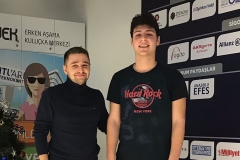
A 'digital' model for the construction industry
Sadık Onur Özden and Tunç Çokuysal, students of Izmir University of Economics (IUE), turned the demand for digitalization in the construction industry
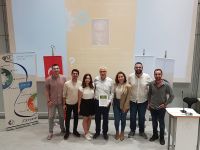
Faculty 101
Industrial Systems Society organized the Faculty101 seminar in our school for the students who begin to the Industrial Engineering Department to introduce



